There has been considerable debate about whether continuous or rotational grazing is the best system (Crowder and Chheda, 1982). Comparison trials between the two have not shown a consistent advantage to either system in temperate areas (see Figure 150), although each system has advantages and disadvantages (see Table 87). Data from a number of grazing trials in tropical areas have been reviewed by Humphreys (1978) and 't Mannetje et al. (1976) who suggested that although differences were small, continuous grazing systems gave slightly higher animal production. Jones and Jones (1989) in a trial with Setaria sphacelata and Chloris gayana noted that liveweight gains did not differ between grasses or between rotational and continuous grazing management systems. Evans et al. (1992) suggest that rotational grazing may result in lower animal production because animals are selective in their grazing behaviour and they have a greater ability to select plants or plant parts under a continuous grazing system. In Sri Lanka although Rajaratnam and Santhirasegaram (1963b) reported that the herbage yield of B. brizantha was slightly higher under rotational grazing, Ramalingam (1961) found no difference in yields under rotational and continuous grazing.
In Malaysia, Najib and Eng (1989) evaluated the milk production potential of imported Sahiwal-Friesian cattle on fertilized Guinea and Signal grass pastures under two grazing systems. They found that rotational grazing (four weeks grazing followed by four weeks rest) gave higher milk yields than continuous grazing, both systems using the optimum stocking rate of four heads ha-1 (see Table 88).
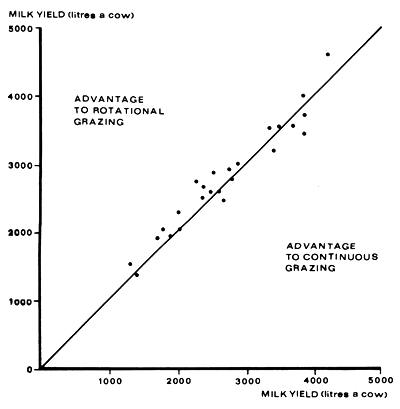
Figure 150. - Trials comparing milk yields per cow under rotational and continuous grazing systems (Wilkinson, 1983c).
Table 87. - The relative advantages and disadvantages of continuous and rotational grazing systems
| System | Advantages | Disadvantages |
| Continuous | Selective grazing by animals which choose most nutritious forage. Lower input required in terms of fencing and watering points. | Patches not grazed become rank and coarse. Trampling and fouling of forage. Tick and worm build up. |
| Rotational | All feed can be grazed; surplus can be cut and conserved. More flexible system. Useful for practical measures like fertilizer application, weed control, coconut harvesting and control of grass-legume balance plus increased farmer-animal contact. May allow certain legumes to flower and set seed. May allow defoliated legumes such as Leucaena to regrow. | Extra sub-divisions and water points required. More attention required to pasture status and labour required to move cattle. Better management skills required. |
Table 88. - Mean milk production of Sahiwal-Friesian cattle grazing improved pasture without concentrate supplementation
| Treatment |  milk production milk production | ||
| kg head-1 day-1 | kg head-1 lactation-1* | kg ha-1 lactation-1 | |
| Guinea | |||
| Continuous | 4.64 | 1,299 | 5,197 |
| Rotational | 5.59 | 1,565 | 6,261 |
| Signal | |||
| Continuous | 5.97 | 1,672 | 6,686 |
| Rotational | 6.60 | 1,848 | 7,392 |
* Lactation period was 280 days
According to Payne (1985) rotational grazing is strongly advocated in the Philippines.
However, if the output of animal products per hectare is a function of both production per animal and the number of animals per unit area (i.e. animal production ha-1 = production head-1 × no. of animals ha-1), then the stocking rate and not the grazing system is the main factor affecting production, (Wheeler, 1962; Whiteman, 1980).
Under coconuts there are a number of reasons why rotational grazing systems may be most appropriate (Liyanage, 1990) and, according to Payne (1985), why they should be preferred:
Various practical tasks like coconut collection, weed control and fertilizer application are more easily carried out with rotational grazing. Rotating the cattle in front of the pick-up labour, so that the forage crop is grazed as short as possible immediately before nut collection, obviously assists in ensuring a high pick-up percentage (Payne, 1985).
Root weight data and observations on the rate of recovery of grasses after clipping indicated that shaded pastures require careful management to avoid excessive depletion of root reserves, either by lenient grazing (to maintain high leaf areas) or by allowing an extended recovery period in a rotational grazing system (Eriksen and Whitney, 1981).
Under low light conditions of many coconut plantations, grasses lose their competitive growth advantage over legumes. It was reported that under continuous grazing some grasses disappeared and swards became legume dominant (Watson and Whiteman, 1981a). In various plantations in Western Samoa M. pudica dominant pastures have resulted from continuous grazing (see Figure 151), whereas good liveweight gains and grass persistence (see Figure 152) were noted under a 28-day rotational grazing regime (Reynolds, 1981).
Some species, such as L. leucocephala, are more productive under rotational grazing than under continuous grazing (Cowan et al., 1993; Jones and Jones, 1982; 't Mannetje et al., 1976), and others, like P. maximum are best rotationally grazed so that overgrazing does not quickly destroy this erect bunch grass (Payne, 1985). Evans et al. (1992) suggest that similar management may be required for other shrub legumes presently being evaluated, such as Calliandra, Gliricidia, Desmanthus, Acacia and Aeschynomene or legumes with a similar growth habit. Hacker and Williams (1993) indicate that Aeschynomene americana is best grazed rotationally whereas Desmodium heterophyllum benefits from sustained heavy grazing.
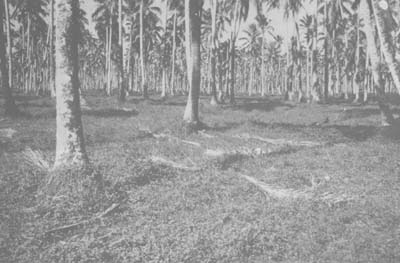
Figure 151. - Native pastures dominated by Mimosa pudica under old coconuts in Western Samoa.
The construction of fences in cattle/coconut systems should also be less costly than it is in many other systems, as growing (coconut) trees can be used as fence posts with suitable wooden batons affixed (also, treated old coconut trunks make excellent posts) or the erection of cheap live fencing is possible using species such as Gliricidia or Erythrina. However, in rubber and oil palm areas Chin (1991) notes that fencing is not popular and most plantations do not encourage construction of permanent fences as they hamper vehicular and human movements relating to the main crop, such as in the harvesting of palm fruits. The alternative of using electric fencing has been tried but the majority of sheep are now grazed under the supervision of shepherds (Halim and Stoeker, 1990).
Moog (1993) notes that the majority of farm lots and coconut farms in the Philippines are not fenced. With grazing experiments perimeter and subdivisional fences were erected. As collection and transport of nuts from plantation to roadside is done with bull carts, “fences, particularly the subdivisional fences, made the movement of the cart difficult… (therefore) … gatherers/harvesters of nuts cut or slashed the fence lines”. Therefore, where rotational grazing systems are adopted (with more fences) this may be a problem which will require local discussion and solution.
Protagonists of continuous grazing would argue that sown grasses also disappeared under rotational grazing of pastures under coconuts in the Solomon Islands (Smith and Whiteman, 1983b), while continuous grazing of improved pastures in Bali should provide good long term production with no deterioration in botanical composition at a stocking rate of about 2 AU ha-1 (Rika et al., 1981).
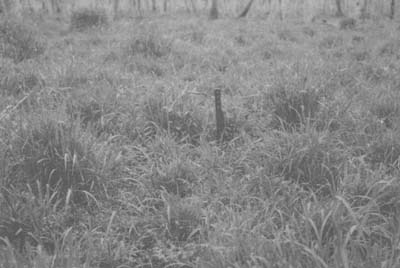
Figure 152. - A good guinea grass (P. maximum) - centro (C. pubescens) stand grazed under a 28 day rotational grazing regime at 1.0 beast ha-1 under 20 year old coconuts (LT 50%) at Vaitele, Western Samoa.
Although the debate will undoubtedly continue, it is suggested that a rotational grazing system is likely to be more appropriate where sown pastures are established under coconuts, particularly where shade is heavier. Where natural pastures are grazed, good liveweight gains and coconut yields are as likely to be achieved with a continuous grazing system as with rotational grazing, still nuts are more easily collected and worm/tick problems may be less where rotational grazing is used. Walton (1972) suggested that rotational grazing increased carrying capacity and Eden (1953), Ellewela (1956), de Silva (1961), Goonasekera (1951) and Javier (1974b) all recommended rotational grazing under coconuts. At smallholder level a third system may be used. Cattle are often tethered and moved to a new tethering point when the forage is exhausted. (See Figure 153).
A rotational system may involve only two paddocks, but four or more paddocks are preferred for flexibility. Although the optimum time for grazing will vary according to species and time of year, the optimum regrowth period is usually between 2 to 6 weeks. In Western Samoa, a rotational cycle of 4 weeks with P. maximum and a number of stoloniferous grasses used by Reynolds (1981) showed good liveweight gains. A similar 28-day rotational cycle was used in grazing trials under coconuts in the Solomon Islands (Smith and Whiteman, 1983b). An example of a rotational grazing system with a 28-day cycle is shown in Figure 49. One grass which probably requires a grazing cycle of only about 2 to 3 weeks is I. aristatum (see section 5.3.3). In the Philippines, to optimize pasture utilization under coconuts, a cutting/grazing interval of 45–60 days at 60 percent utilization has been recommended (Anon., 1982d). Jayawardena (1985) suggests that most pasture grasses under coconuts are ready for grazing once every six weeks, at which time they will be about 45 cm high. They should be grazed or cut to a height of 10 to 15 cm from ground level. Fodder grasses should be cut every 30 to 45 days to a height of 20–30 cm.
In the Ivory Coast, Rombaut (1974) obtained satisfactory liveweight gains with West African Shorthorn cattle under oil palm at 0.5 tropical livestock units ha-1 (i.e., 1 TLU = 250 kg liveweight) with a 60 day rotation on Pueraria dominant swards. In mature plantations rotational grazing (6 × 7 day grazing periods) using a combination of permanent and electric fencing, showed that cattle raising was complementary and could be adapted to the management of a commercial plantation (Mack, 1991).

Figure 153. - Tethered cattle on Guinea grass on a smallholder farm in Tonga.
Rigidity of the system should be avoided, and grazing time in each paddock must be flexible. Daily inspection will indicate the available amount of feed and the best time to move animals. However, a continuous decrease in time for completion of the grazing cycle means that the system is overstocked and likely overgrazed, while a gradually lengthening cycle means understocking, over mature pastures and feed waste (see Figure 155). In a marked dry season (see Figure 156) destocking may be necessary to maintain the same cycle; alternatively, a deferred rotational grazing system may be used to rest paddocks and allow for seed set (Anderson, 1967).
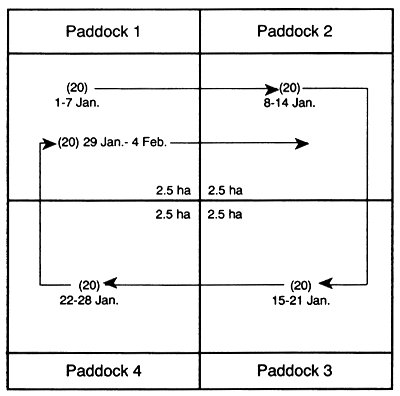
10 ha B. brizantha-C. pubescens under coconuts aged 30 years at spacing 10m × 10m; stocking rate 2.0 steers ha-1 (20 steers on 10 ha)
Figure 154. - Rotational grazing cycle.

Figure 155. - Possible changes of grazing cycle duration over time.
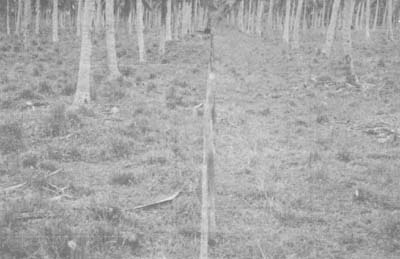
Figure 156. - Guinea - centro pastures overgrazed at both 1.0 (left) and 1.5 (right) animal ha-1 after a long dry spell.
To continually achieve good returns from his pastures, the farmer has to attempt to correctly estimate the number of animals that can be grazed per unit area. At low stocking rates the individual animal performance is high, but declines as the stocking rate increases. However, as there are more animals ha-1 the gains per unit area (which is the principal interest of the farmer) may increase to the point where there are too many animals, causing both performance per individual and per unit to decline. Thus it is important to realize that production can be measured in two ways, i.e. performance by animal and per unit area (ha-1).
Various workers have proposed models describing the relationship between animal production and stocking rate. An exponential model was proposed by Mott (1960), but later Jones and Sandland (1974) found that the relationship between stocking rate and live-weight gain per head was linear and the relation between stocking rate and gain per hectare could be defined by a quadratic equation (Whiteman, 1980). Although there is an optimum stocking rate, the production per hectare declines only gradually on either side suggesting that there is a stocking rate range within which the farmer can achieve good returns without identifying the optimum rate.
Some of these concepts are illustrated in Table 89 and Figure 157 using hypothetical data. Other workers have suggested a different relationship between stocking rate and liveweight gain per animal, with a (convex) curvilinear rather than linear relationship (Hart, 1978).
Table 89. - Hypothetical performance data for beef animals grazing a 10 ha paddock 1)
| No. of animals 10 ha-1 | Gain animal-1 day-1 (kg) | Gain ha-1 day-1(kg) | Total gain ha-1yr-1(kg) |
| 1 | 1.6 | 0.16 | 58 |
| 5 | 1.2 | 0.6 | 219 |
| 10 | 0.8 | 0.8 | 292 |
| 15 | 0.3 | 0.45 | 164 |
| 20 | -0.1 | -0.2 | -73 |
1) Based on data presented by Eriksen and Reynolds at a training course in Western Samoa in 1976.
The most important aspect of health and disease in connection with grazing livestock under tree crops is the problem of internal parasites. According to Parawan (1991) the problem is aggravated by the shading effect which favours parasite egg survival and persistence. In New Zealand, Jackson et al. (1986) have shown that the larval population of ovine infective trichostrongyle larvae survive better under agroforestry regimes than on open pastures. Respiratory diseases tend to become a problem when stocking rates are increased (especially in goats). In Malaysia, high mortality rates of up to 32 percent for sheep (Mohd. Nawi and Ahmad, 1988) and the identification of high incidence (35–42 percent) of pneumonic pasteurella in the mortality list (Wan Mohamed et al., 1988) sustained by animals in the plantations, may relate closely to the very humid and hot environmental conditions under the tree canopies (Chen, 1989). Zamri Saad et al. (1992) noted that where sheep grazed under oil palms (rather than in the open) there were more cases of traumatic injuries, such as foot injuries, due to the thorny nature of the tree (see Figure 158). Also there were more cases of snake bite.

Figure 157. - Relationship between stocking rate and gains animal-1 and ha-1 using hypothetical data.
Kalmbacher and Martin (1983) noted that shaded plants could be susceptible to disease (Fusarium, Phytophera, etc.) for longer periods than faster growing plants under open conditions. The low soil and plant K contents typical of a number of South Pacific island countries, combined with the shade factor may affect the severity of foliar fungal diseases (Matocha and Smith, 1980; Perrenoud, 1977). Shading could also foster a habitat in which succulent, under developed legume seedlings become food for certain insects and snails. In the Solomon Islands, Steel and Whiteman (1980) noted that P. maximum cv Embu and B. miliiformis both suffered considerable insect damage and failed to recover when grown under coconuts with mean light transmission of 30%. In Fiji, Nadi Blue grass (D. caricosum) growing under coconuts becomes infected with leaf rust in the wet season which reduces plant vigour and persistence (Cegumalua et al., 1993).
It was once thought that the presence of weeds in a pasture was a sign of declining fertility. However, it is now known that the presence of certain weeds often reflects management practices rather than soil fertility (Skerman, 1977). A weed is usually defined as any plant growing where it is not wanted. In tropical areas when rainforests are cleared there is a well defined succession back to the original vegetation. Weed growth is the first stage, so even though a tropical pasture mixture is established under coconuts, it is a continuous challenge to management to maintain the pasture when there is a natural succession of weeds and bush regrowth (Skerman, 1977).
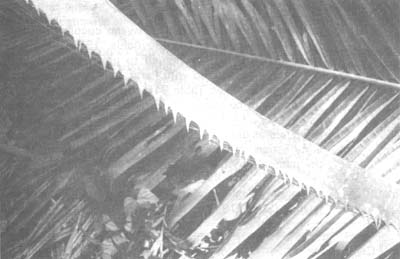
Figure 158. - The serrated edge of the oil palm leaf midrib which can cause foot injuries to grazing animals.
The maintenance of good pasture is primarily a matter of good management, although some farmers believe that weed problems can be solved once they sow/plant improved pastures. Even with adequate fertilizer application this may not be the case, since poor grazing management may lead to weed reinfestation. With consistent over-grazing and the opening of the sward, weeds may become re-established (Guzman and Allo, 1975).
Several surveys demonstrated the seriousness of the weed problem in coconut areas:
A survey in West Malaysia showed that many of the smaller coconut plantations (<40 ha) had a considerable degree of weed infestation principally Chromolaena odorata (Guzman and Allo, 1975; Selvadurai, 1968). In Johore 96 percent of the properties had a ground cover consisting mainly of weeds; in Selangor/Perak and Kelantan the figures were 99 and 64 percent respectively. Principal weed species were Imperata cylindrica, Ischaemum muticum, Mikania cordata and various sedges.
Reports on preliminary results of a survey conducted on small-holder pastures throughout the Solomon Islands, indicated that the major problem facing the smallholder cattle industry was weeds (Steel, 1977; see Table 90).
A later survey conducted on 14 smallholder coconut plantations showed that the weed component of 6–10 years old Batiki pastures averaged 50 percent with a range from <30 to 70 percent depending on the adequacy of weeding management (Litscher and Whiteman, 1982). In general, good weeding practices were demonstrated to produce pastures with significantly less weeds than where poor weeding practices were used. The most common weeds were the ferns: Sphaerostephanos unitus and Nephrolepis hirsutula accounting for up to 50 percent dry matter in many pastures, with Sida acuta and S. rhombifolia contributing from 8–30 percent dry matter in a number of pastures.
In Western Samoa the land between coconut palms is too often covered with unproductive weeds (Reynolds, 1980). On well managed pastures weed percentage was related to grass species, with the highest weed percentage associated with Para grass which was the least shade tolerant of the grasses (see Table 91). So even in well managed pastures, some weeds are to be expected, particularly the bushy and woody species such as Sida spp., Lantana camera and Psidium guajava. Methods of control are the same as detailed in section 5.2.2. The most important need is to take early action to prevent the weeds from seeding, thus regular checking of the pastures by the farmer is recommended.
Table 90. - Mean botanical composition of smallholder pastures, Malaita, Solomon Islands (Steel, 1977)
| Component | % Composition | Range |
| Planted grass | 51 | 8–73 |
| Legume | 2 | 0–23 |
| Volunteer grass | 9 | 0–31 |
| Ferns | 14 | 0–52 |
| Other | 24 | N.A. |
Note: dry weight ranking method of t'Mannetje and Haydock (1963) used.
Table 91. - Effect of grass species on botanical composition percentage of pastures under coconuts after 2 years grazing, May 1978, Western Samoa (Reynolds 1981)
| Components | Grass Species | |||||
| Batiki | Cori | Para | Tall guinea | Palisade | Creeping guinea | |
| Sown grass | 65 | 70 | 42 | 64 | 69 | 65 |
| Centro | trace | 5 | 4 | trace | 1 | trace |
| Mimosa | 7 | 5 | 10 | 3 | 13 | 7 |
| Hetero | 6 | 1 | 1 | 3 | 3 | 4 |
| Weeds | 22 | 19 | 43 | 25 | 14 | 24 |
Even though animal nutrients are being added (urine and manure), these are actually part of a circulation process rather than true additions from outside the cattle-coconut system. To replace soil nutrients removed in the form of coconuts, meat, milk and animals, regular fertilizer applications are necessary unless the soil is very fertile.
Although a small ‘starter’ dose of nitrogen is often used in pasture establishment, the application of large quantities of nitrogen fertilizer can have dramatic effects on the legume component. Presence of high levels of No3- or NH4 + will inhibit nodulation and, in plants already nodulated, reduces rate of nitrogen fixation (Whiteman, 1980). When a legume is growing with a grass, the latter usually competes strongly for available nitrogen, takes up most of that applied, grows rapidly at the expense of the legume often resulting in a reduction in the legume content (Linehan and Lowe, 1960; see Table 92).
The regular application of superphosphate, has been shown to have a significant and positive effect on legume percentage, pasture production and liveweight gain (see Table 93). Wolfe and Lazenby (1973) demonstrated legume percentage changes over time in response to different levels of superphosphate. Without superphosphate, legume percentage had declined by the fourth year to only 1 percent compared with > 10 percent on all other treatments (see Table 94).
Table 92. - Effect of N application rate on yield of Siratro in a Siratro-Rhodes grass pasture (Jones, 1967; Whiteman, 1980)
| N level | Dry matter yield (kg ha-1) | |||
| Siratro | Other spp | Total | % reduction in legume | |
| 0 | 3,700 | 8,000 | 9,000 | - |
| 75 | 3,120 | 7,600 | 10,720 | 16 |
| 225 | 2,500 | 9,400 | 11,900 | 33 |
Table 93. - Effect of superphosphate maintenance rate on legume content and animal performance in a D. uncinatum, L. bainesii, T. repens and D. decumbens pasture (Evans, 1970; Whiteman, 1980)
| Maintenance rate of superphosphate (Kg ha -1) | Legume content % | Liveweight gain (kg ha-1) |
| 125 | 18 | 315 |
| 250 | 24 | 395 |
| 500 | 30 | 505 |
Table 94. - Effect of superphosphate on total annual production of grass- White clover pastures and legume percentage over time1) (Wolfe and Lazenby, 1973)
| Year | DM yield (Kg ha-1) and legume (%) with superphosphate at: | |||||||
| 0 | 42 | 125 | 375 kg ha-1 | |||||
| 1967 | 2,307 | 9.6 | 2,943 | 15.3 | 3,510 | 31.5 | 6,180 | 61.7 |
| 1968 | 1,378 | 3.3 | 1,981 | 12.5 | 3,148 | 33.0 | 5,732 | 43.4 |
| 1969 | 1,707 | 0.6 | 2,958 | 9.1 | 5,284 | 27.5 | 9,412 | 40.3 |
| 1970 | 824 | 1.0 | 1,687 | 13.6 | 3,775 | 32.7 | 6,358 | 27.5 |
1) Pastures sown in September 1966.
In Sri Lanka the recommendation for Brachiaria pastures is to broadcast a mixture of 100 kg sulphate of ammonia and 50 kg each of saphos phosphate and muriate of potash per acre per year in two split doses at the beginning of each monsoon season, (Guzman, 1974). For fodder grasses, such as Guinea and Napier, half of this dose is recommended immediately after each cut.
Although local soil conditions will determine which fertilizer to use, an annual application of 50–100 kg ha-1 of superphosphate or potassic superphosphate where soil potassium levels are low, should stimulate legume regrowth. The amount can be split but application should take place immediately following the grazing which will result in rapid regrowth. Maintenance fertilizer strategies for tropical pastures have been discussed by Andrew and Bruce (1977) and Teitzel (1975), and fertilizer use reviewed by de Geus (1973).
The close relationship between level of fertilizer application, stocking rate and animal production has been described by Humphreys (1972).
If good testing facilities are available, then periodic use of soil and foliage tests can assist when decisions are made on pasture maintenance fertilizer requirements.
So far, emphasis has been on grazing the established pasture. There are, however, three possible ways of harvesting:
Although grazing is the usual method of harvesting pastures, it is rather inefficient in that only about 50 percent of the forage produced is actually consumed (Reynolds and Lovang, 1977a, 1977b; Reynolds, 1978j) - the rest is knocked down, trampled and soiled. In order to remove old material, pastures may be periodically mown or topped so that an even growth of fresh young forage is encouraged.
The grazing system and stocking rate have been emphasized, but there is much more to grazing policy. The farmer must develop a strategy which includes the entire year, all its problems, such as dry season and forage shortages. Thus not all forage produced in the wet season is necessarily grazed. A proportion may be cut and stored as hay or silage for future use or even left as standing hay for dry season grazing. Recently, Stevens (1993) reported on trials underway in Thailand, Indonesia and Malaysia to assess bale-wrapping techniques (with small baling machines) and treatment of high moisture content forages to examine the potential of these techniques for livestock production in the tropics. Koon (1993) provided details of ‘silawrap silage’ making in Malaysia using plastic sheet for airtight wrapped bales. Possible methods of forage conservation for smallholders in Malaysia have been reviewed by Mohd. Najib et al. (1993).
In the tropics cut-and-carry feeding systems (see Figure 159), are widely used because of: small size of holding with limited grazing area, fragmentation of land holdings, lack of fencing in mainly cropping areas and low cost of labour. Cut-and-carry systems are suitable for all plantation crops particularly when the trees are young and vulnerable to damage from grazing animals (Sophanodora and Tudsri, 1991). However as noted by Devendra (1989) the cut-and-carry or stall feeding system requires high investment in labour and capital. “It is a system that favours situations where there is no land or, more particularly, there is an abundant supply of crop residues and agroindustrial by-products. Probably because of the higher capital investment, it has not been adequately used as a system.
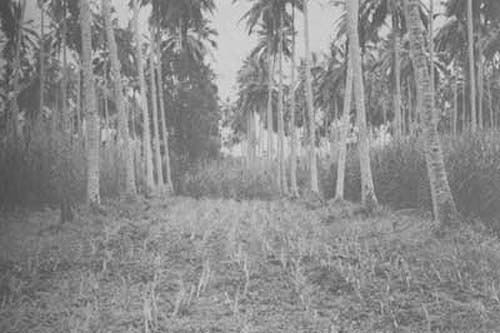
Figure 159. - Blocks of Napier grass used as cut-and-carry feed.
In the cut-and-carry system, a large proportion of the feed is brought in from outside the holding (see Figure 160) because of the small size of the available land in relation to the number of animals kept (see Figure 161). The system is subject to the vagaries of seasonal abundance and shortage of forage that characterize it. Because the animals are housed most of the time, dependence on high priced concentrate feeds increases during periods of forage shortage. The system has had limited success because of the value of arable land for food production. This also presents a constraint to forage production for animals. However, the emphasis on crop production means that large quantities of crop residues are available for use as feeds for ruminants.”
In Thailand, Manidool and Chantkam (1986) emphasized backyard pastures as a realistic approach to forage development for small dairy farms. Small plots of land where available near the house can be converted to productive pasture with little effort. In fact, the concept is already well accepted in Bali, Indonesia, Philippines and Thailand with Hamil guinea or Napier grass on backyard areas being supplemented with leucaena and gliricidia grown on fence lines.
However, cut-and-carry systems extract a considerable amount of nutrients from the forage production area and these are moved to where the animals are fed; particular care is required to return nutrients to the forage area. Neglect to do so may result in loss of coconut yield. This is illustrated in Figure 162, where productivity of three grasses, grown under coconuts, was compared at a two monthly cutting interval over a period of 14 months (Stur et al., 1994). Yield of the tall grass Panicum maximum was initially very high but declined to the level of Brachiaria decumbens, a grass of intermediate height, and within a year declined to a yield level similar to that of the local prostrate grass Axonopus compressus.
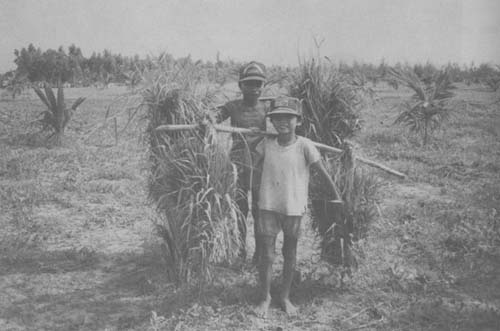
Figure 160. - Young boys carrying freshly cut grass for feeding stalled cattle in Vietnam.
It has been report (Hussain et al., 1983) that goats in Fiji fed sugar came tops, stovers, straws, coconut cake, rice bran and molasses reached liveweights of 23–25 kg in about 22 weeks. Their daily liveweight gain was 154 g, much higher than the 83 g achieved by goats in the traditional extensive system. In Thailand, staff fed Brahman × Charolais × native steers given concentrates and fresh Guinea grass (Panicum maximum) and had an average daily gain of 1.1 kg. When sold, the cattle gave a profit margin of US $ 122–164 per head, which represented about 30–50 % of the capital investment.
In Timor, tethered bulls fatten at an excellent rate of over 1 kg day-1 on an ad lib. diet of leucaena leaves plus a metre of banana stem for moisture each day (Harrison, 1986).
Where land is not limiting for intensive pasture production, either grazing or stall feeding (see Figure 161) can be adopted. In Malaysia (Wong et al., 1987) a comparative study of both systems to examine potential milk production in Sahiwal × Friesian cows on a mixed pasture of Leucaena leucocephala and Brachiaria decumbens indicated that rotational grazing was better than stall feeding (9,180 vs. 8,577 kg ha-1 for each lactation) - see Table 95. Supplementation of rotationally grazed cows with concentrates at 4 and 6 kg cow-1 day-1 further increased milk production to 13,323 and 17,070 kg ha-1 for each lactation respectively. The net profit per cow, with or without supplementation, was higher for rotational grazing on account of the higher labour cost for the staff feeding system.
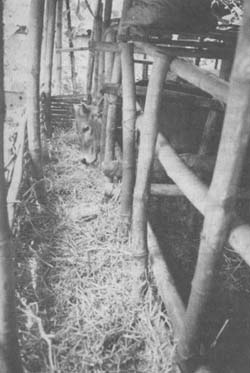
Figure 161. - Stalled cattle being fed a mixture of fresh grass and rice straw, in Vietnam.
Table 95. - Milk yield in Sahiwal × Friesian cows and costs of milk production in two systems of production Malaysia (Wong et al., 1987)
| Conc. supplementation (kg day-1) | Rotational grazing(a) | Cut-and-carry(a) | ||
| 0 | 4 | 6 | 0 | |
| Total milk yield (kg cow-1 lactation-1) | 1,712 | 2,733 | 3,269 | 1,418 |
| Cost kg-1 of milk(b) | 0.13 | 0.14 | 0.15 | 0.19 |
| Gross income at 0.24 cts kg-1 milk(b) | 412.14 | 657.96 | 787.00 | 341.29 |
| Production cost animal-1(b) | 195.59 | 394.77 | 484.29 | 273.04 |
| Net profit cow-1(b) | 216.55 | 263.18 | 302.70 | 68.26 |
(a) L. leucocephala and B. decumbens forage
(b) US$
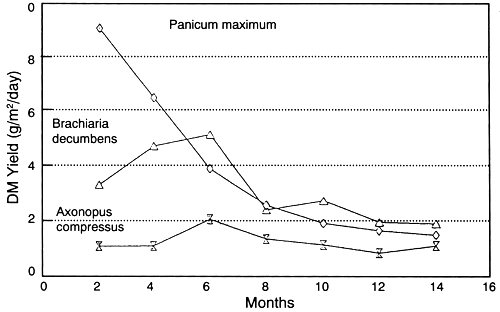
Figure 162. - Yield (g/m2/day) of grasses under coconuts in Bali: unfertilised, cut every two months. After Stur et al. (1994) - I.K. Rika (personal communication).
However, a comparison of a cut-and-carry feedlot system, a semi-feedlot system and free grazing for beef cattle in Johore, Malaysia revealed higher daily liveweight gains for the stall fed animals (Sukri and Dahlan, 1986). Trials carried out with smallholders in West Johore, where coffee was grown as an intercrop under coconuts, used a feed ration consisting of coffee by-products (30%), copra cake (30%), palm kernal cake (37%) Urea (2%) and mineral-vitamin premix (1%) and various native species (Paspalum, Axonopus, Ottochloa, Ischaemum and Brachiaria) for grazing. LID × Jersey crossbred yearling males were used and the first trial lasted for 178 days. The animals under the feedlot system were confined and fed the feed ration ad lib.; the semi-feedlot treatment involved tethering and grazing on the native grasses for five hours daily before the animals received the same feed ration ad lib.; the free grazing animals were tethered to graze the native grasses. Average daily gains of the animals in the feedlot, semi-feedlot and free-grazing systems were 0.48, 0.37 and 0.15 kg respectively. The feedlot and semi-feedlot groups were extended for a further 116 days with average daily gains of 0.60 and 0.38 kg animal-1 respectively. An economic evaluation demonstrated that gross profit was higher for the feedlot animals than the semi-feedlot or grazing groups (see Tables 96 and 97). It was concluded that feedlot and semi-feedlot systems had great potential for increasing beef production among smallholder farmers and should avoid the major problem of low feed availability (and quality); in dry spells. In the Philippines, Posas (1981) noted that goats grazed under coconut had a better liveweight gain ha-1 year-1 than goats fed under a cut-and-carry system. This would suggest that at least for goats, grazing is a more efficient method of pasture utilization than cut-and-carry (Parawan 1991a).
The advantages and disadvantages of cut-and-carry or zero grazing systems have been described by Whiteman (1980):
| Advantages | Disadvantages |
| Efficient use of forage. | Higher labour input needed to cut-and-carry fodder. |
| Less wastage from trampling | Greater labour resources needed to dispose of excreta. |
| Saving of grazing energy. | More capital required in structures, equipment and possibly fuel costs. |
| Less soil damage. | Less opportunity for animals to select forage. |
| Less labour required to herd stock. | Cutters may select low quality feed. |
| Water reticulation not required. | Too little feed may be given to animals. |
| Less capital needed on fencing. | Urine may be lost and dung may be returned to areas other than forage producing areas, resulting in a soil fertility decline. |
| Animals may need supplementation with coconut cake, rice bran, etc. |
Table 96. - Economic Evaluation - Phase 1 (after Sukri and Dahlan, 1986)
| Parameter | Group1 | Grazing | |
| Feedlot | Semi-feedlot | (Control) | |
| Expenditure | |||
| Avg feed intake (kg day-1) | 4.5 | 2.7 | - |
| Cost of ration kg-1 (¢)2 | 22.1 | 22.1 | - |
| Cost of ration day-1 ($) | 0.99 | 0.60 | - |
| Revenue | |||
| Avg daily gain (kg day-1) | 0.48 | 0.37 | 0.15 |
| Revenue from gain ($ day-1)3 | 1.68 | 1.30 | 0.53 |
| Gross Profit | |||
| Gross profit ($ day -1) | 0.69 | 0.70 | 0.53 |
| Margin over semi-feedlot (%) | 30.2 | 32.1 | - |
1 Average per animal
2 Based on cost of feed ingredients
3 Based on cost of cattle at $ 3.50 kg-1 liveweight
Harvesting or cutting interval depends on pasture species, soil fertility, time of year, climate and method of harvesting. (For the effect of cutting interval on dry matter yield of Siratro sown with grasses see section 5.3.2, and for the optimum time for grazing, see section 5.3.3). Although the usual response is to find that yield of pasture is substantially greater if the interval between cutting or grazing is long (see Table 98), the higher yield of dry matter produced under a lenient cutting or grazing system is often of lower nutritive value than the younger material. Furthermore severe and frequent defoliation reduces the vigour and survival of trailing legumes because of their reliance on rooted stolon production (Jones, 1967, 1974a; Whiteman, 1969). In a cutting experiment at Bouar (Central African Empire) the dry matter yields of pasture declined from 3,400 kg ha-1, where pasture was cut three times during the growing season, to 3,200 kg ha-1, when cut six times, 2,800 kg ha-1 when cut eight times and only 2,500 kg ha-1 when cut twelve times (Bille and Hédin, 1968). In Malaysia cutting trails with five tropical grasses demonstrated similar relationships between dry matter yield and cutting interval (see Table 99) but also a decline with time (Wan Hassan et al., 1990). It was concluded that smallholder dairy farmers have a range of forage grasses to choose from, all of which appear capable of producing high dry matter yields of moderate quality with reasonable persistency if cut at 6-week intervals (this interval appeared to give the best compromise between dry matter yield, forage quality and persistency). Concentrate/mineral/legume supplementation would be necessary for dairy cattle.
Table 97. - Economic evaluation - Phase 2 (after Sukri and Dahlan, 1986)
| Parameter | Group1 | |
| Feedlot | Semi-feedlot | |
| Expenditure | ||
| Avg feed intake (kg day-1) | 5.2 | 3.0 |
| Cost of ration kg-1 (¢)2 | 22.1 | 22.1 |
| Cost of ration day-1 ($) | 1.15 | 0.66 |
| Revenue | ||
| Avg daily gain (kg day-1) | 0.60 | 0.38 |
| Revenue from gain ($ day-1)3 | 2.10 | 1.33 |
| Gross Profit | ||
| Gross profit ($ day-1) | 0.95 | 0.67 |
| Margin over semi-feedlot (%) | 41.8 | - |
1 Average per animal
2 Based on cost of feed ingredients
3 Based on cost of cattle at $ 3.50 kg-1 liveweight
Table 98. - Effect of cutting interval on yield of Digitaria decumbens (Bryan and Sharpe, 1965)
| Cutting interval days | Yield kg ha-1 year-1 |
| 28 | 7 700 |
| 56 | 12 600 |
| 84 | 19 400 |
In Sri Lanka, Liyanage (1986) suggested that fodder grasses should be harvested once every 30 to 45 days with exact harvesting interval depending upon climatic conditions. In Brazil (Alcantara, 1985) a 9-week cutting frequency for the first year and 12 weeks for the second year was shown to result in the best elephant grass (P. purpureum) performance (DM and CP).
According to Edgely and Quinlan (1975) the optimum grazing cycle is 2–6 weeks, while Middleton and Teitzel (1973) indicated that a 6–8 week system gave good results at South Johnstone in Queensland in terms of pasture utilization and plant survival. Using Digitaria decumbens and shortening the grazing cycle from 40 days to 32 days the daily increase for steers was from 1.21 lb day-1 (0.55 kg day-1) to 1.42 lb day-1 (0.65 kg day-1) (Creek and Nestel, 1960). Under rotational grazing the main aim of a good forage volume, at a favourable nutritive level, is usually achieved with a cycle length of about 30–40 days. Slightly longer cycles would favour trailing legumes but some grass species like batiki grass (I. aristatum) and Pemba grass (S. dimidiatum) probably benefit (in terms of level of achieved animal production), from a shorter cycle of only 20–30 days because protein values fall quickly as the pasture matures.
Various experiments have demonstrated interactions between frequency of defoliation (or regrowth interval) and cutting height (Jones, 1973; Ludlow and Charles-Edwards, 1980; Middleton and Teitzel, 1978; Riveros and Wilson, 1970). Severe defoliation can have a very serious effect upon the plants' ability to regrow, Crider (1957), Oswalt et al., (1959) and Davidson (1969) showed that severe defoliation can stop root growth, resulting in only slow root extension for a period of 6–18 days afterwards reducing nutrient uptake and thus plant vigour. In these circumstances more vigorous weed species may invade the pasture.
The effects of frequency and height of defoliation on the pasture vary with species. Plants with buds close to the ground are more able to withstand heavy grazing pressure than those with exposed grazing points. Some scientists suggest that grazing practice should be guided by the need to maintain a certain critical leaf area (L.A.I.) to ensure maximum net photosynthesis. Brougham (1956) found that swards defoliated to 13 cm maintained a fairly constant rate of growth, whereas swards defoliated to 8 cm took 16 days before sufficient light was intercepted to reach the critical L.A.I.; thereafter growth rates were similar to the pastures defoliated to 13 cm. Swards defoliated to 2.5 cm required 24 days before the critical L.A.I. was reached. However, simple application of this L.A.I. concept to grazing practice has not been possible (Jones, 1974b).
In general grasses like Napier should not be cut or grazed below about 20–30 cm and Guinea below about 15–20 cm. An average grazing height is about 15 cm while some grasses like Batiki, Pemba or Carpet grass are able to tolerate hard grazing down to 5 cm. Grasses like Napier should not be allowed to grow taller than about 1–1.5 m before grazing (although as Napier is usually harvested by cut-and-carry methods a height of 2–2.5 m may be reached before cutting), while most grasses should be grazed before they reach the 1 m mark. MacFarlane et al. (1992) suggest that the best way to judge correct stocking rate is from the height of the grasses and legumes in the pasture. They suggest average grazing heights at which pasture grasses should be maintained:
| Koronivia (B. humidicola) | 15–20 cm |
| Buffalo (S. secundatum) | 10–15 cm |
| Carpet (A. compressus) | 10–15 cm |
| T-grass (P. conjugatum) | 10–15 cm |
| Signal (B. decumbens) | 30–40 cm (15–20 cm according to Mullen and Banga, 1993) |
| Guinea (P. maximum) | 50–60 cm (40–50 cm according to Mullen and Banga, 1993) |
| Para (B. mutica) | 45–55 cm |
| Sabi (U. mosambicensis) | 25–35 cm |
For farmers, particularly smallholders this may be the best way to judge whether they have too few, too many or the correct number of animals ha-1.
However, height is not the only criterion, important also are maturity, protein content and stage of growth. Also, pastures may be closed out to allow seed to set and drop thus thickening the stand.
Table 99. - Mean dry matter yield of five tropical grasses at four cutting intervals over a three year period in Malaysia (after Wan Hassan et al., 1990).
| Cutting interval (wk) | Year 1 | Mean | SE (15 d.f.) | Year 2 | Mean | SE (15 d.f.) | Year 3 | Mean | SE (15 d.f.) | ||||||||||||
| Set1 | Dig | Nap | Gui | Sig | Set | Dig | Nap | Gui | Sig | Set | Dig | Nap | Gui | Sig | |||||||
| DM yield (ha-1) | |||||||||||||||||||||
| 2 | 4.0 | 4.9 | 3.3 | 3.5 | 5.1 | 4.2 | 0.8 | 2.1 | 0.6 | 1.7 | 2.5 | 1.5 | n/a | n/a | n/a | n/a | n/a | n/a2 | |||
| 4 | 12.0 | 14.8 | 10.2 | 12.9 | 12.0 | 12.4 | 5.8 | 4.8 | 4.7 | 7.9 | 4.5 | 5.5 | 7.0 | 6.7 | n/a | 5.9 | 6.4 | 6.5 | |||
| 6 | 24.8 | 28.0 | 24.9 | 23.2 | 25.0 | 25.2 | 1.20 | 14.3 | 9.8 | 9.3 | 12.6 | 10.1 | 11.2 | 0.42 | 15.8 | 14.1 | 12.7 | 16.2 | 15.3 | 14.8 | 0.57 |
| 8 | 36.4 | 38.3 | 52.3 | 44.5 | 40.6 | 42.4 | 19.9 | 12.5 | 21.3 | 20.1 | 14.5 | 17.7 | 21.2 | 15.7 | 19.6 | 20.2 | 18.5 | 19.0 | |||
| Mean | 19.3 | 21.5 | 22.7 | 21.0 | 20.7 | 10.2 | 7.3 | 9.0 | 10.6 | 7.9 | 14.7 | 12.2 | 16.1 | 14.1 | 13.4 | ||||||
| SE (4 d.f.) | 1.69 | 0.85 | 1.27 | ||||||||||||||||||
1 Grasses Setaria sphacelata, Digitaria setivalva USDA 299892, Pennisetum purpureum, Panicum maximum, Brachiaria decumbens.
2 n/a - not applicable as grasses had died out by the third year.
In the Philippines, Mendoza (1985) noted that Leucaena yielded more edible forage when a cutting height of at least one metre was maintained, compared with a recommended cutting height of 15–30 cm (see Table 100).
Table 100. - Dry matter yield (ton ha-1 yr-1 of Leucaena harvested at different cutting heights and frequencies (after Mendoza, 1985)
| Height | Frequency (weeks) | |||
| 8 | 12 | 16 |  1 1 | |
| 15 cm | 11.00 | 9.54 | 11.49 | 10.68 |
| 1.5 m | 17.82 | 14.34 | 15.18 | 15.78 |
| 3.0 m | 24.07 | 22.80 | 23.97 | 23.61 |
 2 2 | 17.62 | 15.56 | 16.88 | 16.69 |
1 Means are significantly different from each other at 1% level
2 No significant differences among frequency means.
However, data presented by Preston (1992) showed little effect of cutting height on the forage yield of Gliricidia sepium (see Figure 163).
When improved pastures are introduced under coconuts, the farmer may have to change his pasture management methods and coconut management practices, so that they are complimentary. Where a rotational grazing system is adopted, then collection of coconuts should follow the grazing cycle so that collection is made from areas with short grass where coconuts are exposed and easily located.

Figure 163. - Effect of cutting height on forage yield of Gliricidia sepium (after Preston, 1992).
Not only is there a drastic reduction in forage dry matter yield (see Figure 38) at low light transmission levels (i.e. in very shady conditions) but regrowth and sustainability of forages can be poor if the resource is overgrazed. In order to ensure that sufficient feed is available to maintain his herd, a farmer must adjust the stocking rate according to the soil type, age of the plantation crop (and thus the light penetration), the weather and season, the extent to which the forages were previously grazed and the composition of the forage. Particularly important are reserve or additional areas of grazing adjacent to the plantation area such as grazing strips (see Figure 164) along electricity power (pylon) lines for cattle under oil palm in Malaysia (personal observation and Mohamad Ngah et al., 1991). Continuous overgrazing will result in the loss of the more palatable species, an increase in unpalatable species and productivity decline. Tajuddin and Chong (1991) noted that under mature rubber only with a low stocking rate of 2 sheep ha-1 was continuous grazing sustainable and at higher stocking rates (of 4, 6 and 8 sheep ha-1) the amount of forage was drastically reduced and the population of Cyrtococcum oxyphyllum, an unpalatable weed, increased. Also, as illustrated by Chen and Shamsudin (1991) under oil palm, grazing pressure should be adjusted to the amount of feed available under tree crops otherwise the reproductive performance of livestock will be affected.
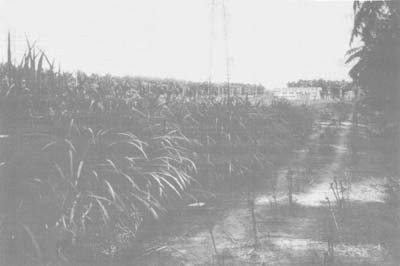
Figure 164. - Reserve forage areas along electricity pylon lines adjacent to oil palm areas, Malaysia.
Sustainable agricultural systems are characterized by inputs and outputs and in terms of physical inputs such as water, soils and total and plant available nutrients necessary to drive the systems, losses and gains to the system should be in balance. Different agro-eco systems have limits to inputs and outputs which if exceeded, lead to non-sustainability. A stable pasture system is able to meet the nutritional requirements of pasture plants and grazing livestock without depleting the soil resource in the longer term, although there may well be seasonal or cyclical species fluctuations. “The persistence of introduced species in pastures depends on the survival of plants from the original sowing, and the recruitment of new plants. Management of establishing pastures aims to at least maintain and preferably increase the initial population”. (McIvor et al., 1993). As shown in Figure 165 “The subsequent size of the population is the net result of recruitment and mortality …. recruitment must at least equal mortality for the species to persist” (McIvor et al., 1993). MacFarlane (1993a) mentions pastures in Vanuatu (Signal grass/native legume pastures) which have had a stable botanical composition and stable rates of steer turn-off to the abattoir for 18 years! He also mentions pastures consisting of carpet grass and the native legumes Desmodium canum and Mimosa pudica which are likely to remain botanically stable at 2 animals ha-1 but signal grass/sown legume (centro, shaw vigna, puero, Malawi glycine, Glenn joint vetch) pastures at 2.5 animals ha-1 which are heading towards an unsustainable grass dominant situation after only two years of grazing.
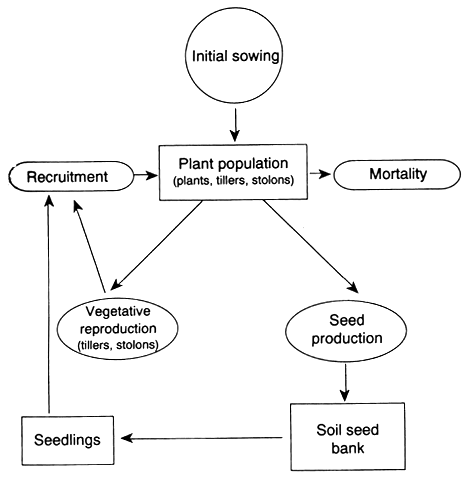
Figure 165. - Components of plant population changes of pasture species (McIvor et al., 1993).
Similarly in Western Samoa under old coconuts (light transmission > 80%) Reynolds (1981) demonstrated that para grass pastures degraded rapidly and became heavily weed infested under stocking rates of 2.1 and 2.5 steers ha-1. They were ploughed up after only two years because the system was not sustainable under the shaded conditions and at the stocking rates used.
In discussing the pasture-cattle-coconut eco-system in Vanuatu Berges et al. (1993) refer to it as a relatively stable eco-system with a natural productivity of about 30–60 kg of meat ha-1 yr-1 (i.e. about 60–120 kg liveweight ha-1 yr-1). “Any change in this equilibrium requires corresponding investments… the intensification level determines the production level”. MacFarlane et al. (1992) recommended various (sustainable) stocking rates for Vanuatu (see Figure 146) and sustainable levels of individual animal growth and production ha-1 for various humid tropical pastures were given by MacFarlane (1993a) - see Table 101.
While ecological stability is an important aspect, MacFarlane (1993a) stresses that sustainable agricultural systems must also be socio-economically sustainable. In Vanuatu, the Pasture Improvement Project has been successful because the adoption of new, appropriate technologies has not contributed significantly to workloads sufficient to reduce the output from other important household functions and resulted in significant gains in productivity and household disposable income.
Table 101. - Sustainable levels of individual animal growth and production per hectare reported for humid tropical pastures (modified from MacFarlane, 1993a)
| Pasture type | Stocking Rate | Average liveweight gains | Reference | |
| per animal | per ha. | |||
| Guinea + centro/puero/glycine | 2.0 (350–500)* | 0.60 | 439 | MacFarlane et al. (1993) - Efate, Vanuatu |
| Guinea + centro/puero/glycine | 2.5 (350–500) | 0.57 | 520 | - Efate, Vanuatu |
| Guinea + centro/puero/glycine | 2.5 (300–500) | 0.65 | 594 | - Santo, Vanuatu |
| Koronivia + centro/mimosa | 2.5 (300–500) | 0.56 | 505 | MacFarlane et al. (1993) - Santo, Vanuatu |
| Para + centro | 2.7 (194–400) | 0.55 | 547 | Watson & Whiteman (1981b) - G' Canal Plains |
| Signal + mimosa/centro | 2.7 (350–500) | 0.55 | 542 | MacFarlane et al. (1993) - Efate, Vanuatu |
| Signal + zero-till sown leg. | 2.0 (350–550) | 0.69 | 504 | unpubl. VPIP data - Efate - 15 mths data only |
| Signal + centro/puero/glycine | 2.5 (300–500) | 0.58 | 531 | MacFarlane et al. (1993) - Santo, Vanuatu |
| Carpet + native legumes | 2.0 (300–440) | 0.38 | 272 | - Santo, Vanuatu |
| Carpet/Buffalo + native leg. | 2.6 (250–350) | 0.30 | 285 | Evans et al. (1992) - Montmartre, Efate |
| Carpet + centro/mimosa** | 2.5 (140–330) | 0.35 | 318 | Smith & Whiteman (1985) - Yandina Sol. Is. |
| Buffalo + hetero/vigna | 2.0 (250–350) | 0.52 | 380 | Evans et al. (1992) - East Santo smallholder |
* Average liveweight range or mean liveweight in brackets.
** under 65% light transmission coconuts.
Livestock will show certain patterns of forage selectivity and preference which usually reflect the degree of palatability of the forage species. Thus, sheep grazing under rubber (Tajuddin and Chong, 1991) demonstrated, in descending order, the following species preference:
A dramatic example of forage selectivity by grazing cattle is demonstrated in Figure 166 where the white marker separates grazed hybrid elephant grass from Hawaii (Napier 3418 from a cross of USDA 1915 Import Napier and USDA Merker) from ungrazed ‘local’ elephant grass (P. purpureum) in Western Samoa. There is no fence line between the two, the difference representing animal preference for the hybrid elephant!
When livestock are grazed for a long period on the same area the palatable species will be heavily grazed (and may even disappear) leaving behind the less or non-palatable species such a Eupatorium odoratum, Lantana camara, and Asclepias curassavica, some of which may be toxic and require removal by hand-weeding or selective herbicide spraying to prevent their spread and to allow the more palatable species to regrow (Chen et al., 1991; Mack, 1991).
In various trials under the shade of plantation crops such as coconut, oil palm and rubber, sown grasses and legumes such as Brachiaria decumbens, Brachiaria mutica, Brachiaria humidicola, Centrosema pubescens and Calopogonium mucunoides have not persisted under regular grazing (Chen et al., 1978; Rika, 1986; Smith and Whiteman, 1985; Watson and Whiteman, 1981a; Wong, 1991). Ultimately they are replaced by naturalized species of lower productivity. Thus, in the Solomon Islands after three years grazing of sown pasture at 1.5, 2.5 and 3.5 beasts ha-1, all the improved grasses disappeared (reduced from 28% to 0%). Hassan and Abdullah Sani (1991) noted that after one year of grazing by buffalo under oil palm the percentage of puero, ferns and centro declined to be replaced by high levels of Paspalum conjugatum, Calopogonium caeruleum and Asystasia intrusa.
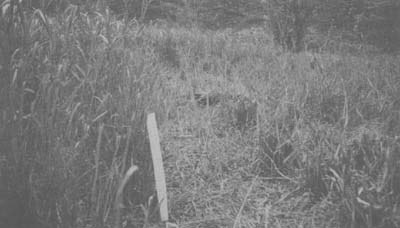
Figure 166. - Forage selectivity by grazing cattle at Vaea Farm, Western Samoa.
In Malaysia in areas with leguminous covers such as P. phaseoloides and C. caeruleum mixed with weeds such as A. intrusa and P. conjugatum, sheep were able to perform very effective legume purification work which otherwise could not be done effectively by either hand-weeding or selective spot spraying. Sheep selectively grazed out A. intrusa and P. conjugatum and lightly browsed on P. phaseoloides. However, if the animals were kept for a longer period, they would graze out the P. phaseoloides and lightly browse the C. caeruleum resulting in an almost pure C. caeruleum sward which is encouraged in rubber plantations (Tajuddin and Chong, 1991). A similar process has resulted in natural pastures under coconuts in Western Samoa becoming heavily dominated by Mimosa pudica after many years of grazing by cattle. (See Figure 151).
The time spent grazing by livestock will depend to a large extent on the amount and quality of the feed available. The time spent by sheep either grazing, walking or resting during the six hours grazing time in a fixed paddock system in Malaysia is shown in Table 102. Sheep spent more time grazing (90.8 percent) under mature rubber than under immature rubber (74.4 percent). The probable reason was that under mature rubber, where the amount of forage on offer was low (< 300 kg ha-1), sheep had to browse more in order to satisfy their feed requirements. Under immature rubber, where the amount of forage was relatively higher (960–1,200 kg ha-1), sheep required less grazing time as they could satisfy their nutritional needs faster. Free grazing sheep spent considerable time walking in search of palatable feed (Tajuddin and Chong, 1991).
Table 102. - Grazing behaviour of sheep in fixed paddocks in mature and immature rubber (after Tajuddin and Chong, 1991)
| Rubber Age Group | Grazing % | Walking % | Resting % |
| Immature | 74.4 | 4.2 | 21.4 |
| Mature | 90.8 | 2.8 | 6.4 |
Animal response to pastures depends on the quantity available throughout the year and its nutritional value. Pasture productivity and the level of animal production are controlled through the management of both pastures and livestock. The way in which such management is carried out will determine the long-term productivity and profitability of the beef or dairy enterprise. Management for sustained productivity has to be flexible because of changing circumstances arising from unexpected events such as climatic effects or economic (market) forces (Evans et al., 1992). Macfarlane et al. (1992) suggest that where there are shaded and open pastures, cows and calves are best run under shade (i.e. under coconuts), reserving open pastures for post-weaning growth.
Although there have been many references to cattle grazing pastures under coconuts (and often stocking rates and the general effect of pastures on copra yields are mentioned), only in the last two decades has information become available on livestock production levels. The performance and production of ruminants under rubber and oil palm in Asia and Pacific regions have been well documented by Abraham et al. (1978) and Vidyadaran et al. (1988).
In Jamaica (Anon., 1971b) Guinea grass, Pangola grass and natural pasture under ‘Jamaica Tall’ coconuts at 100 palms ha-1 were indicated to provide 612, 320 and 282 cow grazing days ha-1 year-1. Santhirasegaram (1959) showed that in Sri Lanka Paspalum commersonii provided only 284 grazing days ha-1 year-1 compared to 450 for B. brizantha, 408 for B. miliiformis and 675 for P. maximum.
In Western Samoa grazing trials were initiated under coconuts in 1972 and 1973. Average weight gains head-1 day-1 over the period July 1973 to July 1974 were 0.49 kg on fertilized Guinea-Centro compared with 0.17 kg on unfertilized local pastures (Reynolds and Schleicher, 1975). Reynolds carried out six grazing trials between August 1974 and May 1978 and reported on four. In trial 1 (see Table 103 and Figure 167) steers on fertilized Guinea grass-Centro pastures produced double the liveweight gains of steers on local pastures, with adequate drinking water. Similar results were obtained in trial 2 where (under very dry conditions) liveweight gains were highest on fertilized Guinea-Centro (See Table 103). Provision of adequate drinking water in the frequent dry spells improved liveweight gains. Over a 118 day period on local pastures liveweight gains, where adequate drinking water was available, were 59 kg ha-1, whereas without water the gain was only 1 kg ha-1. The largest difference in liveweight gains between paddocks with and without water supply occurred in periods characterized by little rain, while the least difference occurred in the wet periods. Data from a similar trial are shown in Table 3. Shirley (1985) has reviewed the effect of water deprivation on feed intake and utilization by grazing ruminants and the findings reported here are consistent with a decrease in feed intake and loss in body weight during periods of water deprivation. MacFarlane et al. (1992) suggest that access to water for smallholder cattle in Vanuatu will improve cattle growth by at least 20 percent.
In trials 3 and 4, (see Table 104) liveweight gains were considerably higher on improved rather than on local pastures. In trial 3, Batiki, Cori, Para and tall Guinea outyielded local pastures in terms of weight gains ha-1 by 77 to 161 percent. In trial 4, characterized by dry conditions, all improved pastures outyielded the local ones by 115 to 212 percent in terms of gains head-1 and ha-1 (P<0.05).
Figure 167. - Grazing trials in Western Samoa.

a. Fertilized Guinea-Centro pasture after 84 days grazing at 1.8 steers ha-1.
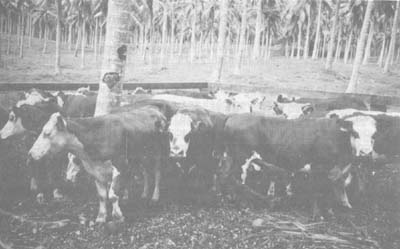
b. Hereford steers from the fertilized Guinea-Centro treatment at the end of grazing Trial 1.
The data reported by Robinson (1981) from Western Samoa for the period 1978–1980 show that with higher stocking rates, much higher gains ha-1 are possible (see Table 105). Differences between local and improved pastures were small in Trial 1 but in Trial 2 Cori outyielded local by 86 percent in terms of gain ha-1. The relatively high yields on local pastures were probably due to the high crude protein levels resulting from the high Mimosa pudica content (Reynolds, 1981).
Table 103. - Liveweight gain data from pastures under coconuts, Western Samoa (Reynolds, 1981)
| Treatment/Species | Gain (kg head-1) | Gain (kg ha-1) | Stocking Rate (steers ha-1) |
| Trial 1 (271 days) | |||
| Unfertilized local-water | 23b | 39c | 1.7 |
| Unfertilized local + water | 47b | 80bc | 1.7 |
| Unfertilized Guinea-Centro | 73ab | 124abc | 1.7 |
| Fertilized Guinea-Centro | 105a | 189a | 1.8 |
| Trial 2 (365 days) | |||
| Unfertilized local | 82c | 148b | 1.8 |
| Unfertilized Guinea-Centro | 125b | 225ab | 1.8 |
| Fertilized Guinea-Centro | 170a | 306a | 1.8 |
| Unfertilized tall Guinea | 120b | 264a | 2.2 |
| Fertilized Koronivia | 129b | 232a | 1.8 |
Note: Values with a common letter are not significantly different at P <0.05 (Duncans
New Multiple Range Test). Trials carried out under coconut palms about 20 years
old, spaced 9.1 m2 with a light transmission at noon (on a clear sunny day) of
about 50 percent of open conditions (measured with a Lamda Quantum Sensor).
All pastures contained indigenous Hetero (Desmodium heterophyllum) and Mimosa
(Mimosa pudica).
Fertilizer was: 250 kg ha-1year-1 of 30 percent potassic superphosphate (7% P,
14% K) split into two equal applications.
Trial 1: May 20, 1976 - February 15, 1977.
Trial 2: April 4, 1977 - April 13, 1978.
Mean annual rainfall: 2929 mm Steer liveweight: 250–450 kg.
In the Solomon Islands, animal performance was compared at various stocking rates on natural and improved pastures over a three year period from 1975 to 1978 (Watson, 1977; Watson and Whiteman, 1981a). Differences between fertilized natural and improved pastures were small, probably because of the disappearance of improved grasses under continuous grazing over the trial period and the high legume content of the natural pastures (see Table 106). However, stocking rate effects were highly significant (P<0.01), liveweight gain per head declining linearly with increasing stocking rate. Only the animals in the low stocking rate (1.5 animals ha-1) natural pasture, attained the target slaughter weight of 400 to 425 kg (see Table 107). Considering that light transmission was only 60 percent of full sunlight, the authors concluded that these gain rates compared very favourably with those on open pastures on the Guadalcanal Plains (Watson and Whiteman, 1981b), thus suggesting the following optimum stocking rates for fattening steers on these pastures: 2.5 animals ha-1 for steers 1–2 years old and 1.5 animals ha-1 for those 2–3 years old.
Table 104. - Liveweight gain data from pastures under coconuts, Western Samoa (Reynolds, 1981)
| Treatment/Species | Gain (kg head-1) | Gain (kg ha-1) | Stocking Rate (steers ha-1) |
| Trial 3 (129 days) | |||
| Local | 37a | 77a | 2.1 |
| Batiki | 65a | 136a | 2.1 |
| Palisade | 46a | 96a+ | 2.1 |
| Cori | 81a | 169a | 2.1 |
| Para | 75a | 157a | 2.1 |
| Tall Guinea | 59a | 201a | 3.0 |
| Trial 4 (365 days) | |||
| Local | 51b | 127b | 2.5 |
| Batiki | 109a | 273a | 2.5 |
| Palisade | 155a | 389a | 2.5 |
| Cori | 158a | 396a | 2.5 |
| Para | 143a | 358a | 2.5 |
| Tall Guinea | 134a | 336a | 2.5 |
| Creeping Guinea ++ | 146 | 366 | 2.5 |
Note: Values with a common letter are not significantly different at P<0.05
(Duncans New Multiple Range Test).
+ Figure low because some animals escaped from trial area and not weighed for several periods when other animals made significant gains.
++ Not included in range test because one replicate only.
Trials carried out under coconut palms 50 to 70 years old, spaced 9.1 m2 with a light transmission at noon (on a clear sunny day) of 70–84 percent.
Fertilizer: as for Table 50 except that local was unfertilized.
Trial 3: May 28, 1976 – March 30, 1977.
Trial 4: May 10, 1977 – May 9, 1978.
Mean annual rainfall: 2929 mm. Steer liveweight: 250–450 kg.
It was unfortunate that Para grass was chosen as it has been found to be very shade intolerant (Boonklinkajorn, 1978; Gutteridge and Whiteman, 1978) and declines quickly under coconut shade, especially under continuous grazing. Not surprisingly it was concluded that there was no advantage in cultivating and sowing an introduced pasture if compared with thoroughly weeding and then grazing the existing naturalized pasture.
The trial continued with the selection of Cori (B. miliiformis) and Signal (B. decumbens) grasses as the most suitable species for the shaded environment; both natural and improved pastures were grazed on a “4 week in - 4 week out” rotation (Smith and Whiteman, 1983b). Liveweight gains are shown in Table 108; there were no differences in gains between natural and sown pastures in the grazing years 1980–81 or 1981–82, but in 1982–83 natural pastures had superior production per head and per hectare.